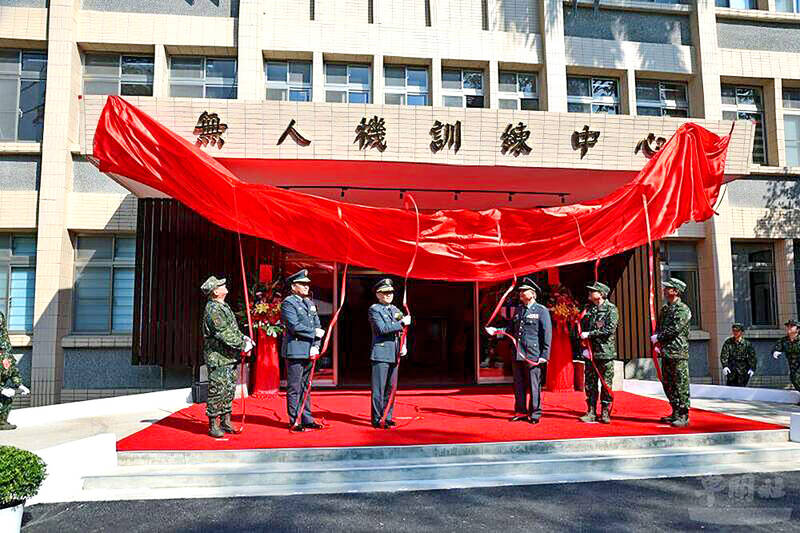The army on Friday inaugurated its Uncrewed Aerial Vehicle (UAV) Training Center, with Vice President Hsiao Bi-khim (蕭美琴) and Minister of National Defense Wellington Koo (顧立雄) in attendance watching a brief exercise demonstrating its capabilities in using drones for reconnaissance and combat.
The center is part of the army’s Education, Training and Doctrine Development Command, and is tasked with teaching basic drone operations and maintenance, as well as fostering teaching talent, drone tactics, and research and development, Commander of Army Headquarters General Lu Kun-hsiu (呂坤修) said.
The center’s inauguration symbolized the army’s advances in developing asymmetrical combat capabilities, he said.

Photo courtesy of Military News Agency
Drones would be a critical force and component in future warfare, and the army’s focus on drones also demonstrates that the army is aware of developing trends for future warfare and is making efforts to embrace those trends, Lu said.
Hsiao, making the visit at the Neijiao Base on behalf of President William Lai (賴清德), thanked the center’s officers and soldiers for their dedication and hard work over the past year, and their families for their support.
Lai has instructed that the military should keep abreast of new technologies, such as drones and artificial intelligence (AI), and mull the utilization of such technologies to improve national security, Hsiao said.
Hsiao said the Lai administration emphasized the development of various types of drone platforms for military use, such as submersible drones and stealth-capable maritime drones, and other military-specification drones allowed for commercial use.
In line with this focus, the government has developed an Aerospace and Drone Industry Park in Chiayi County’s Minsyong Township (民雄), using the west wing of the Chungshan Institute of Science and Technology complex in the area, she added.
The government has also encouraged private companies to focus on drone development and become part of the global supply chain for drone components or manufacturing, she said.
In an interview with Lithuanian National Radio and Television on Dec. 16 last year, Hsiao said that Taiwan hoped to collaborate with like-minded partners worldwide to develop AI, which would play a significant role in future industries.

Beijing could eventually see a full amphibious invasion of Taiwan as the only "prudent" way to bring about unification, the US Department of Defense said in a newly released annual report to Congress. The Pentagon's "Annual Report to Congress: Military and Security Developments Involving the People's Republic of China 2025," was in many ways similar to last year’s report but reorganized the analysis of the options China has to take over Taiwan. Generally, according to the report, Chinese leaders view the People's Liberation Army's (PLA) capabilities for a Taiwan campaign as improving, but they remain uncertain about its readiness to successfully seize

HORROR STORIES: One victim recounted not realizing they had been stabbed and seeing people bleeding, while another recalled breaking down in tears after fleeing A man on Friday died after he tried to fight the knife-wielding suspect who went on a stabbing spree near two of Taipei’s busiest metro stations, Taipei Mayor Chiang Wan-an (蔣萬安) said. The 57-year-old man, identified by his family name, Yu (余), encountered the suspect at Exit M7 of Taipei Main Station and immediately tried to stop him, but was fatally wounded and later died, Chiang said, calling the incident “heartbreaking.” Yu’s family would receive at least NT$5 million (US$158,584) in compensation through the Taipei Rapid Transit Corp’s (TRTC) insurance coverage, he said after convening an emergency security response meeting yesterday morning. National

Taiwan has overtaken South Korea this year in per capita income for the first time in 23 years, IMF data showed. Per capita income is a nation’s GDP divided by the total population, used to compare average wealth levels across countries. Taiwan also beat Japan this year on per capita income, after surpassing it for the first time last year, US magazine Newsweek reported yesterday. Across Asia, Taiwan ranked fourth for per capita income at US$37,827 this year due to sustained economic growth, the report said. In the top three spots were Singapore, Macau and Hong Kong, it said. South

PLANNED: The suspect visited the crime scene before the killings, seeking information on how to access the roof, and had extensively researched a 2014 stabbing incident The suspect in a stabbing attack that killed three people and injured 11 in Taipei on Friday had planned the assault and set fires at other locations earlier in the day, law enforcement officials said yesterday. National Police Agency (NPA) Director-General Chang Jung-hsin (張榮興) said the suspect, a 27-year-old man named Chang Wen (張文), began the attacks at 3:40pm, first setting off smoke bombs on a road, damaging cars and motorbikes. Earlier, Chang Wen set fire to a rental room where he was staying on Gongyuan Road in Zhongzheng District (中正), Chang Jung-hsin said. The suspect later threw smoke grenades near two exits